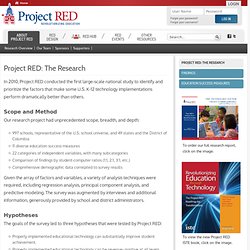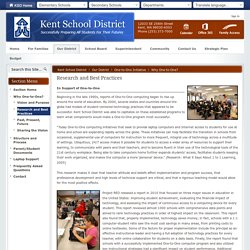

Research Overview - Project RED. Project RED: The Research In 2010, Project RED conducted the first large-scale national study to identify and prioritize the factors that make some U.S.

K-12 technology implementations perform dramatically better than others. Scope and Method Our research project had unprecedented scope, breadth, and depth: 997 schools, representative of the U.S. school universe, and 49 states and the District of Columbia 11 diverse education success measures 22 categories of independent variables, with many subcategories Comparison of findings by student-computer ratios (1:1, 2:1, 3:1, etc.)
Given the array of factors and variables, a variety of analysis techniques were required, including regression analysis, principal component analysis, and predictive modeling. Hypotheses The goals of the survey led to three hypotheses that were tested by Project RED: Properly implemented educational technology can substantially improve student achievement. The Project RED survey analyses support these hypotheses. Predchart1. One-to-One / Research and Best Practices. In Support of One-to-One Beginning in the late 1990s, reports of One-to-One computing began to rise up around the world of education.

By 2000, several states and countries around the globe had models of student-centered technology practices that appeared to be successful. Kent School District was able to capitalize on these established programs to learn what components would make a One-to-One program most successful. “Today One-to-One computing initiatives that seek to provide laptop computers and Internet access to students for use at home and school are expanding rapidly across the globe.
These initiatives can help facilitate the transition in schools from occasional, supplemental use of computers for instruction to more frequent, integral use of technology across a multitude of settings. In 2005, Kent School District had an evaluation of the Kent Technology Academy completed by an outside research firm. 5 Questions To Ask Before Using Tablets In School. Tablets are not for everyone. Most people are perfectly capable of making it through the day checking email, reading, and watching videos on their smartphone until they can make it home to their laptop. That being said, tablets were sent from on high for student life. They’re cheaper and easier to transport than laptops, yet they’re more substantial and full-featured than smartphones. Schools and colleges all over the country have taken note of tablets’ potential for enhancing the educational experience and many have begun to provide them for students.
If your school has stiffed you but you still want a tablet, here’s a snapshot courtesy of our content partners at Online Degrees of what the market looks like right now for academic users. How Much Does Price Matter? High school and younger students may have a bit more (of their parents’) money to work with when it comes to buying a tablet, but we’re assuming price is the top consideration for you cash-strapped college kids. Four Reasons Why School Tablet Rollouts Can Stumble - Or Fail.
Nothing's perfect.

In creating my map of the 120+ back-to-school iPad and tablet deployments this fall, I learned a few things about what can cause trouble for schools and students. These are good lessons for businesses and other types of organizations thinking about going mobile. (Check out my list of the 100 Largest iPad Rollouts, which with my recent research has become very school-heavy). 1) Deploying iPads - and then doing nothing else. My colleague John Fontana - he writes the ZDNet blog on privacy technology, Identity Matters - is stridently unimpressed by the iPad deployments at his son's high school. "They talked about cutting edge, digital natives, blah, blah, blah. "Anyway, no text books, no apps, no home work, no digital assignments happened on the iPad all year," he continued. There are multiple sins here: an old-fashioned mindset, a lack of integration into the curriculum and evidently no training for the teachers. You can even create your own e-textbooks. 10 Things School Leaders Do to Kill a Teacher's Enthusiasm for Technology.
Learning-is-Personal.pdf.